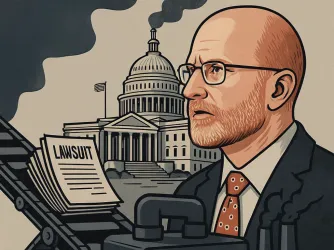Table of Contents
SPLC Warns College Presidents: Don’t Mess with the First Amendment
Last week we reported that both Raj K. Chopra of Southwestern College (SWC) and Darrel Hammon of Laramie County Community College (LCCC) abruptly resigned as presidents of their institutions in the midst of First Amendment controversies. We were pleased to see that the steps taken by faculty members and others who thought they were not being treated fairly on campus came to fruition, paving the way for what we hope is a new era of robust free speech at both schools. We hope this is a signal to college presidents everywhere that free speech should be taken very seriously on college campuses.
Frank LoMonte, executive director of the Student Press Law Center (SPLC), sounds the same notes in a blog post yesterday. He writes:
Oh, that First Amendment karma. When it bites back, it bites back hard.
Darrel Hammon of Laramie County Community College in Cheyenne, Wyo., comes from the land of bighorn sheep. Raj Chopra of Southwestern College in Chula Vista, Calif., comes from the town of cougars. But they share a great deal in common - including, as of this past week, lots of free time to get together and commiserate.
Chopra stepped down as president of Southwestern on Dec. 2, ending a tumultuous tenure that included a no-confidence vote by faculty and a rare "probationary" accreditation by the Accrediting Commission for Community and Junior Colleges.
Hammon resigned as head of LCCC on Nov. 29 [effective Dec. 31], having lost the confidence of many students, employees and trustees after a string of incidents including the mishandled dismissal of the school's vice president for student services.
Both presidents had violated free speech rights on their campuses. Chopra's administration suspended four faculty members (later reduced to three) for participating in a protest that strayed beyond SWC's unconstitutional free speech zone, a small patio area. Hammon's administration tried to keep out of the public eye a report that criticized his handling of an international trip with LCCC students.
LoMonte notes that like fearful dictators under clouds of controversy, both presidents took to the offensive:
As the media filled with reports that their respective presidencies were unraveling, Hammon and Chopra did what embattled autocrats always do: attacked the media.
Hammon's administration actually went to court on a bogus claim of student confidentiality, attempting to convince a judge to restrain a Wyoming newspaper from publishing a leaked internal investigation that reflected poorly on the president's handling of a student's suicide threat. [This attempt briefly succeeded.]
Chopra's administration shut down the student newspaper, The Sun, on the dubious justification of a never-enforced contracting technicality. The order appeared "coincidentally" timed to suppress coverage of a fiercely contested Board of Trustees election in which Chopra loyalists were being challenged. (Cooler heads - and the law - prevailed, and the presses were allowed to roll after only one missed issue, enabling Sun readers to enjoy a front-row seat to Chopra's final crash-and-burn.)
But freedom of speech is not a right to be tampered with. LoMonte finishes with this message to college presidents:
Insecure leaders whose grasp on power is uncertain almost invariably overreach to silence the independent media that give voice to their critics. It would be an overstatement to say that trampling on press rights was the cause of either president's downfall. More accurately, such behavior is the danger signal of a bunker-bound administration spiraling toward flame-out. That's the tactical flaw when presidents circle the wagons - they find out the hard way that the wagon they're shooting at is their own.
Well said. We're glad to have the SPLC among our frequent, strong allies in defending students' rights.
Recent Articles
Get the latest free speech news and analysis from FIRE.

Inside the Trump administration’s extortion-industrial complex

In Philly, a new generation finds its voice — and the tools to defend it

Say it with a song
